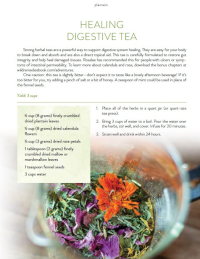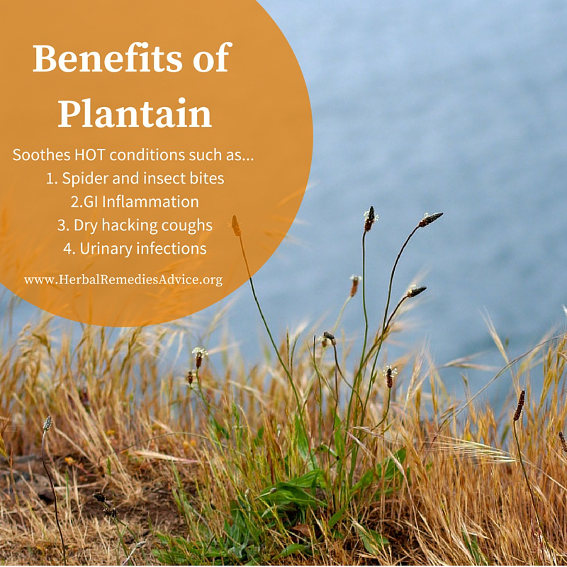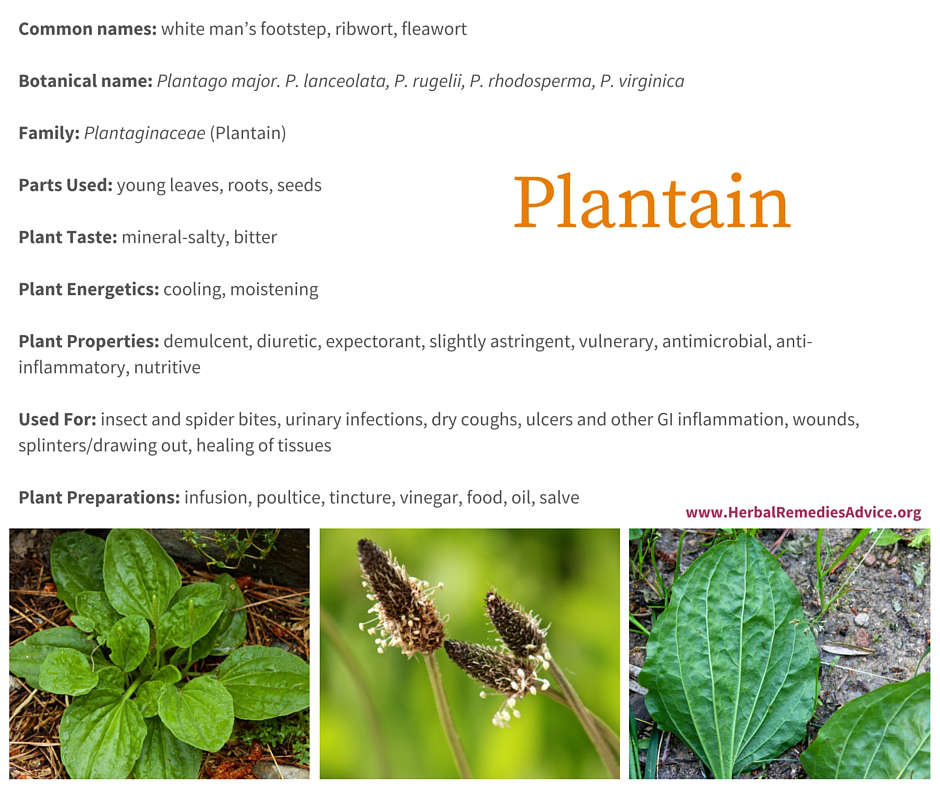Get weekly tips, recipes, and my Herbal Jumpstart e-course! Sign up for free today.

Plantain Herb
Share this! |
|
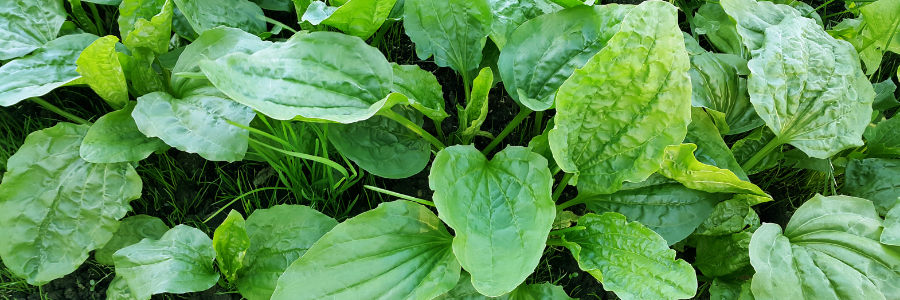
There are so many plantain herb benefits! What some may dismiss as common or even a pesky weed is actually a powerhouse of medicine. Plantain leaf can help to soothe a range of complaints from itchy bug bites to irritating coughs to persistent wounds to an inflamed gut.
You’ll come away from this with a great overview of this versatile herb’s many gifts, tips for plantain identification and lots of ideas for working with plantain safely and effectively.
You’ll also receive instant access to a plantain leaf tea recipe so next time you (or someone you love) is recovering from a stomach flu or other stomach upset, you’ll be prepared.
Be sure to stick around to the end to get my recipe and free recipe card for plantain leaf tea.
-- TIMESTAMPS --
- 00:00 - Introduction to the plantain herb (Plantago spp.)
- 03:15 - Plantain for hot conditions
- 05:23 - Plantain for bites and stings
- 06:36 - Plantain for wounds
- 08:53 - Plantain for excessive histamine response and seasonal allergies
- 09:43 - Plantain for gastrointestinal inflammation
- 10:54 - Plantain for the lungs
- 12:09 - Plantain seeds
- 13:31 - Plantain identification (Plantago major, Plantago lanceolata, and Plantago rugelii)
- 15:55 - Working with the plantain plant
- 17:53 - Plantain Leaf Tea recipe
- 20:24 - Plantain Fun Fact
Download Your Recipe Card!
Transcript of the Plantain Herb Video
Don’t be deceived by the humble plantain plant! What some may dismiss as common or even a pesky weed, is actually a powerhouse of medicine ranging from everything from irritating coughs to persistent wounds to even healing radiation damage. That’s right! There are so many plantain plant benefits and I’m going to share them with you in this video and I’m also including a recipe for a healing plantain leaf tea.
Plantain
holds an especially dear place in my heart. It was the first herb I
learned when I started my herbal journey almost 20 years ago. Even after
all this time, this plant still amazes me! In this video I’ll share
important information about plantain benefits so you can work with it
safely and effectively. Be sure to stick around to the end to get my
recipe and free recipe card for a healing plantain leaf tea.
And,
while you’re watching, let me know in the comments below about your
experience with plantain plant benefits. It’s always interesting and
insightful to hear the experiences of plant lovers out there. Your
suggestion may also help others!
Okay let’s dive in!
As you’re going to see there are many plantain plant benefits!
Yet,
despite its many attributes, plantain is a humble and persistent plant.
It doesn’t boast vibrantly colored flowers. Its leaves often hug the
ground, or grow tall to blend in with the surrounding grass. It can
thrive in hard packed soils with lots of foot traffic and it loves
disturbed areas.
Best of all, if you know how to spot it, you can most likely find this herbaceous perennial whenever you need it. There are about 200 species worldwide, with about 30 native and 5 introduced species in the US.
The first time I heard plantain benefits being discussed, I immediately thought of plantains, the edible fruit that is related to the banana. This isn’t that plantain! I’ll share more about identification in just a bit.
Plantain Herb for Hot Conditions
Whether this is your first video with me or your 20th, you should know that I love herbal energetics and consider this an essential part of herbalism. Without herbal energetics it’s hard to really know how herbs work and how to get the best results when working with them.
You could simply memorize many of the benefits of plantain; however, you would be missing out on understanding its special affinities. You will have a deeper understanding of its abilities when you view it through the lens of its energetic properties.
Plantain herb is energetically cooling and it excels when used to counteract hot conditions.
What is a hot condition?
Hot conditions are characterized by signs of heat, including feeling hot, redness (or sometimes yellow), sharp pain, swelling, and inflammation. Burns are an obvious example of a hot condition as the burned area feels hot and turns red. A red, hot, itchy rash would be another example. A fresh plantain poultice can soothe burns and rashes by both pulling out the heat and healing the damaged tissue.
If you’re new to the concepts of herbal energetics and understanding if a plant or a condition is hot or cold or damp or dry then I highly recommend my free Herbal Jumpstart Course.
This short video course takes you through the ins and outs of herbal energetics and by the time you finish you’ll have increased your herbal knowledge 10 fold.
This course is entirely free to everyone who joins my herbal newsletter community. In addition to getting the free Herbal Jumpstart Course you’ll also hear from me every Wednesday with my best herbal tips and recipes. Look for the link to sign up in the video description.
Choose the best herb for you!
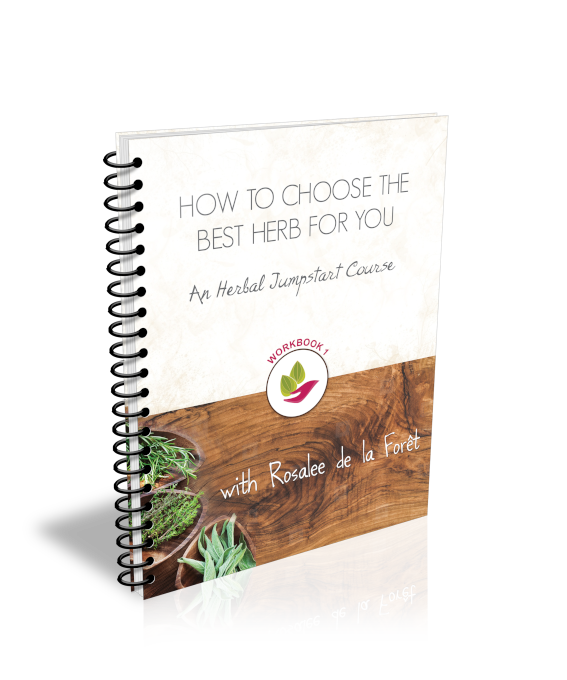
The secret to using herbs successfully begins with knowing who YOU are.
Get started by taking my free Herbal Jumpstart course when you enter your name and email address.
By signing up for my free course you’ll also be joining my weekly newsletter where I send my best tips and herbal recipes. I never sell your information and you can easily unsubscribe at any time.
Okay, back to plantain.
Plantain Herb for Bites and Stings
Another example of a hot condition is bites and stings from insects, spiders, and scorpions. Let’s take a bee sting for example. When a bee stings a person it releases its venom into the skin. Fairly quickly, the area around the sting will swell, turn red, and feel hot to the touch. The pain is generally sharp (as opposed to a dull ache).
Plantain herb is perfect for this “hot” condition. A fresh poultice of the leaves has the ability to pull the poisons from the skin and dramatically decrease the redness, swelling, and pain. I’ve seen this work again and again on many different types of bites and stings. For best results apply the plantain as quickly as possible after the sting and change the poultice every 20 minutes or when it feels warm to the touch. A plantain salve will also work well, especially on common itchy insect bites, like those from flies and mosquitoes.
Plantain Herb for Wounds
Plantain herb stitches together many types of wounds, from minor cuts and scrapes to blisters to hemorrhoids and postpartum tears. It makes a wonderful all-purpose salve, poultice, or sitz bath (combined with other herbs such as Calendula). Because it has the ability to draw things out, plantain is perfect for splinters, boils, or even puncture wounds.
Plantain is also antimicrobial, so it helps to prevent bacterial growth in wounds as they heal. Examples of infections and wounds that are a great match for plantain include boils, eye infections, or urinary tract infections. I like to combine Echinacea with plantain when specifically dealing with infections
Plantain has also been shown to heal wounds and irritations caused by radiation. Oral mucositis caused by radiation is common in patients undergoing treatment for head and neck cancer. In a randomized double blind, placebo-controlled trial, patients were given either a syrup made with plantain or a placebo. After 7 weeks those taking the plantain syrup had significantly less severe symptoms including significantly less pain.
By the way, calendula has also been shown to reduce the negative effects of radiation exposure during cancer treatment. When you’re finished with plantain, look for my video and podcast all about calendula.
Plantain can also heal stubborn wounds like diabetic foot ulcers and pressure ulcers. A human clinical study published in 2022 showed that patients who used a 10% plantain extract gel saw a significant reduction in wound size compared to those using a placebo. Many patients in the trial were completely healed with the plantain gel!
Another double blind randomized clinical trial that used both plantain and aloe vera concluded that these plants are an effective, cheap, and safe treatment for diabetic foot ulcers.
Plantain Herb for Excessive Histamine Response and Seasonal Allergies
Plantain herb can also be taken internally to modulate an excessive histamine response to stings or from seasonal allergies. I learned from Matt Wood (or was it Kiva Rose, or maybe jim mcdonald?) that fresh plantain tincture combines well with peach leaf/twig tincture for calming overly reactive tissues that create symptoms such as runny nose, itchy and runny eyes, sneezing, or dramatic responses to bug bites.
Plantain Herb for Gastrointestinal Inflammation
Plantain is an obvious choice for many first aid or acute inflammations, but it is equally useful for chronic hot conditions, especially in the digestive tract.
A strong plantain leaf infusion (tea) can be one of the most dramatic healers for inflammatory digestive problems, including intestinal permeability (leaky gut), ulcers, and inflammatory bowel diseases. In this situation, plantain soothes the inflamed tissues, helps to heal the tissues (vulnerary), prevents bacterial overgrowth (antimicrobial), and can seemingly knit those tissues back together (astringent).
It can also be a powerful healer for the upper digestive tract. It can relieve the pain of canker sores and speed up the healing of the tissues. It’s also a nice tea to include for people who have acid reflux, as it can soothe and heal the tissues of the esophagus.
Plantain Herb for the Lungs
Besides being cooling for hot conditions, plantain is also moistening (demulcent). These two qualities make it ideal for hot and dry lungs, resulting in chronic or acute coughs. My favorite application for this is the dry, hacking cough that hangs on long after your upper respiratory infection has healed. In this situation, anti-tussive herbs may temporarily stop the cough but, by addressing the root cause (heat and dryness leading to irritation), you can more effectively alleviate the cough and change the dry conditions in the lungs.
Herbalist jim mcdonald specifically recommends plantain for coughs that result from the inhalation of fine particulate matter, which might be experienced in a work environment or during wildfires or weather conversions.
A recent study showed that children using a cough formula consisting of mallow, elecampane, plantain, and helichrysum had an earlier significant reduction in night and day time coughing than children treated with the placebo.
Plantain Seeds
While herbalists often use the plantain leaves, we can’t overlook the many benefits of plantain plant seeds.
Plantain seeds are mucilaginous and high in fiber. Seeds collected from Plantago ovatum or P. psyllium are harvested on a large scale and sold as “psyllium” seed and husk, which are used to maintain bowel regularity.
The seeds from Plantago major, P. rugelii, and P. lanceolata can be used similarly, but the process of harvesting enough of those tiny seeds is time consuming. Plantain seeds also are deliciously edible and can be eaten raw or added to cooked foods, or whole plantain seed stalks can be steamed and eaten if the seeds are too tedious to collect.
These seeds are also medicine! A trial in 2021 showed that psyllium seeds used as a fiber supplement could reduce small dense LDL particles in children at risk for heart disease.
The seeds can also heal the gut. An in vitro study on the seeds shows promise for its ability to strengthen the intestinal wall which could possibly help with intestinal impermeability or leaky gut.
The Plantain Plant
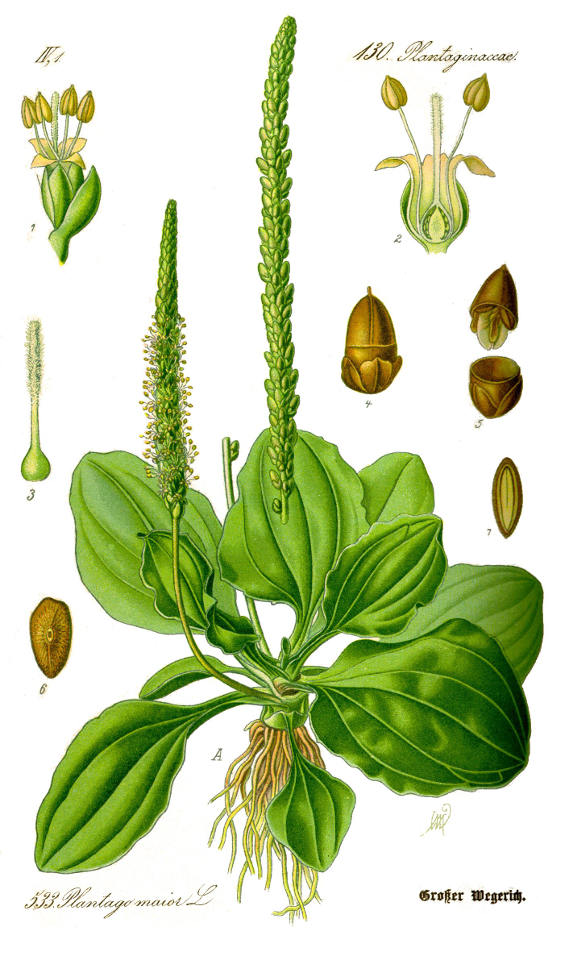
Okay, let’s discuss how to find and correctly ID the plantain plant. This is important. As I mentioned before, when I first heard of plantain I thought immediately of one of my favorite dishes when I was living in the Dominican Republic, platanos!
But the plant we’re talking about now isn’t even closely related.
There are over 200 species within the Plantago genus.
There are two types of plantains that are regularly used as medicine.
One type is commonly called broadleaf plantain. It has oval or egg shaped leaves. Plantain major (European native) and P. rugelii (US native) are both examples of broadleaf plantain. From a practical point of view, these plantains are interchangeably used. From a botanical point of view, they are separate species.
One distinctive property is that the base of the leaf stems of P. major are white, whereas the base of the P. rugelii stems are reddish.
The other type of plantain, Plantago lanceolata, has long narrow leaves and is commonly called narrowleaf plantain.
Both the broad-leaved and narrow-leaved plantains have prominent parallel leaf veins. If you gently pull the leaf apart, you will see the strings that run through the leaf veins.
Plantago major and P. lanceolata are originally from Eurasia and now grow practically everywhere. They love roadsides, lawns, pathways, and disturbed soils.
Plantain flowers grow in dense spikes that rise above the leaves of the plant. The flowers are wind pollinated and the plant reproduces mostly by seed.
I am often asked which plantain is best. As far as I can tell, each of these three species (and many others) can be interchangeably used. To answer even more practically, the best one is the one you find growing at your feet.
Using Plantain Herb
When using plantain for bites and stings, fresh leaves are preferred. A simple spit poultice is often the best choice. To make a spit poultice, chew up a fresh leaf or two until the cell walls are broken and you have a gooey, green leaf poultice. Place this on the affected area. A whole leaf can be used to cover the poultice and a Band-aid® or gauze can further hold the poultice in place. Any hesitation you may feel about how this green mess looks will quickly be forgotten as it soothes the pain and swelling or itching.
I prefer fresh plantain. However, if you live in an area where plantain disappears from summer heat or under winter snow, you can keep some dried plantain leaf on hand and it can be rehydrated with warm water to make a soothing poultice or fomentation. Or you can blend up fresh plantain plant leaves with just a bit of water and then freeze that for later use.
When infusing plantain into an oil for a salve, wilt the fresh leaves slightly or use a hot water bath method. When making a tincture, fresh plantain leaves are also preferred.
The young fresh leaves make a great salad green, cooked green, or pesto addition that is high in nutrients, especially minerals that are often lacking in modern diets. As the leaves mature, the strings in the prominent leaf veins can make the experience more like flossing than eating. You can avoid this by chopping the leaves cross-wise to cut the strings into short pieces. If your young plantain leaves are still too bitter, you can blanche them first to remove some bitterness.
Plantain leaves are wonderful as a strong infusion (tea) for healing digestive wounds, for general GI inflammation.
And that’s what I am sharing with you. This powerfully healing tea recipe really works! Admittedly, this isn’t the best-tasting tea ever. I wouldn’t serve this for Sunday brunch or any time you’re looking for a yummy pot of tea! However, what it’s lacking in flavor it makes up for it in efficacy. It’s medicinal and it is very effective. If it’s too bitter for you you can try adding a bit of salt, which counteracts bitterness, or dilute it with water.
This particular recipe comes straight from my second book, Wild Remedies: How to Forage Healing Foods and Craft Your Own Herbal Medicine. This book is perfect for you if you want to learn more about the plants growing near you. Included with each herbal chapter is safety information, sustainable harvest instructions and lots of fun and easy recipes like this.
To make this tea you’ll need.
- ½ cup (8 grams) dried plantain leaves
- 1⁄2 cup (8 grams) dried calendula flowers
- 1⁄4 cup (3 grams) dried rose petals
- 1 tablespoon (2 grams) finely crumbled dried mallow or marshmallow leaves
- 1 teaspoon fennel seeds
- 3 cups water
To make this tea.
1. Place all of the herbs in a quart jar (or quart-size tea press).
2. Bring 3 cups of water to a boil. Pour the water over the herbs, stir well, and cover. Infuse for 30 minutes.
3. Strain well and drink within 24 hours.
If you’d like a free printable recipe card of this plantain tea recipe, then visit the link above this transcript.
Or, pick up a copy of my book, Wild Remedies, to get more insights and recipes for plantain and many other plants.
Plantain Herb Side Effects
Plantain herb is regarded as safe and there are no common allergies or adverse effects associated with its use.
Plaintain Herb Fun Fact
Plantain has a special place in my heart. It was the first herb I learned about when I started my herbal journey and I think it’s the perfect example of herbalism as the “people’s medicine.” When the Eurasian plantain herbs came to North America they were named white men’s footsteps because they grew readily on the wagon wheel tracks of immigrants heading across North America.
Their weedy growing habits often make them disdained, but plantain is actually a bandaid for disturbed soils and impacted soils. Their roots help to break up hard dirt. Their leaves shelter the soil from the sun and provide food and shelter for other beings. But that’s not all. Plantain is an amazing plant for cleaning the soils they grow in! One study found that plantain growing near mines and smelting plants had fifteen times higher cadmium, lead, and zinc. That’s right! From soothing bee stings, to quelling coughs, to healing digestion, and even to helping to clean our distressed soils, plantain is filled with countless gifts.

Rosalee is an herbalist and author of the bestselling book Alchemy of Herbs: Transform Everyday Ingredients Into Foods & Remedies That Healand co-author of the bestselling book Wild Remedies: How to Forage Healing Foods and Craft Your Own Herbal Medicine. She's a registered herbalist with the American Herbalist Guild and has taught thousands of students through her online courses. Read about how Rosalee went from having a terminal illness to being a bestselling author in her full story here.
